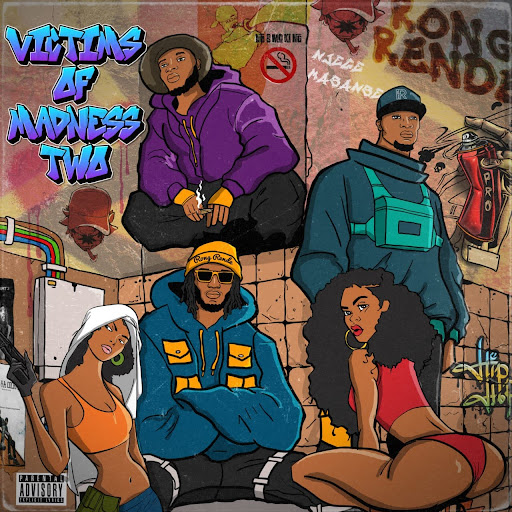When Wakadinali dropped Victims of Madness 2.0, they did more than release an album; they gifted their fans a raw, defiant portrait of urban Kenyan life, threading music and community into one living organism. This second installment in ‘The Victim Of Madness‘ series cements the trio’s role as urban griots lyrical storytellers whose verses double as communal confessions, survival guides, and subtle protests. Through each bar and beat, Wakadinali reminds us that music isn’t just a soundtrack to life; it’s a catalyst that binds people who might otherwise drift alone in a city that often feels hostile.
From the outset, the album’s raw energy is unmistakable. The opening tracks, such as “Intro” Kitu Sewer and “Chizi,” immediately immerse the listener in a world where survival is an everyday battle and hope is both fragile and fiercely protected. Wakadinali’s use of English, Swahili, and Sheng ,the vibrant street language of Nairobi, roots their music deeply in the local context, making their message both accessible and authentic to their core audience. This linguistic fusion is not merely stylistic; it is a deliberate act of community-building, forging a shared identity among listeners who see their realities reflected in the lyrics. One striking thing about ‘Victims of Madness 2.0’ is its honest storytelling.
Tracks like “No Money No Job” and “Story Ya Life” lay bare the everyday struggles of Nairobi’s youth. Wakadinali doesn’t romanticize street life, they document it. In doing so, they give listeners a mirror to see their own challenges reflected, turning individual pain into a shared narrative. When fans hear these verses, they realize they’re not alone in their hustle; their stories are etched into the songs, woven into the larger fabric of the community the group is nurturing. This sense of belonging is powerful, especially in a city where many young people feel invisible and unheard.
But Wakadinali’s music isn’t just about highlighting problems; it’s about turning survival into swagger. Songs like “Mjanja Mjini” (which loosely translates to ‘smart in the city’) and “Dream Team” are sonic pep talks that infuse grit with hope. The beats hit hard, the hooks are bold, and the lyrics remind you that no matter how broken the system is, you can still stand tall with your people by your side. There’s a subtle defiance in how these tracks fuse everyday realities with an aspirational edge, urging listeners to stay sharp and stick together. This is how music builds community: by giving people anthems that reaffirm they’re part of something bigger than themselves.

‘Victims of Madness 2.0’ is also, at its core, an open forum for social commentary. Throughout the album, the group confronts uncomfortable truths about inequality, corruption, and the day-to-day grind of Nairobi’s working class. Songs like “Vile Nawawasha” hint at the exploitation that festers beneath the surface of urban life. By putting these realities to a beat, Wakadinali creates a public space where listeners can reflect, vent, and even mobilize. The album becomes a conversation starter, one that extends beyond club speakers and car stereos into daily life. It transforms music from passive entertainment into an active, unifying force for discussion and, sometimes, dissent.
The cyphers, skits, and layered collaborations throughout the album mirror the communal ritual of performance that Kenyan hip-hop thrives on. Tracks like “Rong Cypher 3.0” pull in multiple voices, each verse building on the last like a lyrical relay. These moments capture the essence of the live show culture that Wakadinali champions: rowdy, participatory, and inherently collective. Even when you listen alone through your headphones, you can feel the crowd’s energy, the echo of call-and-response, the unspoken agreement that we’re all in this together. In this way, the album itself becomes a stand-in for the physical spaces where community is forged whether that’s a dingy club in Eastlands or an impromptu street performance.
Interspersed throughout the album are skits and interludes that echo real conversations and moments from everyday life. These segments lend the project a cinematic quality, blurring the line between music and lived experience. They serve as reminders that behind every statistic or headline is a human story—one marked by humor, pain, and hope. This narrative approach not only grounds the album in reality but also fosters a sense of intimacy and solidarity among listeners.
One of the album’s most powerful contributions is its challenge to prevailing narratives about crime and urban youth. Rather than sensationalizing or condemning, Wakadinali invites listeners to consider the circumstances that drive individuals to the margins of society. The title itself, “Victims Of Madness,” reframes the conversation: it is not simply about perpetrators of crime, but about those caught in the crosscurrents of a broken system. The music asks us to empathize, to see beyond stereotypes, and to recognize the collective responsibility for societal outcomes.
Collaboration is another cornerstone of the album’s community-building ethos. Featuring artists like Suzanna Owiyo, Sudough Doss, and Abbas Kubaf, “Victims Of Madness 2.0” brings together diverse voices and musical styles, from Afro-fusion to classic hip-hop. These collaborations not only enrich the sonic landscape but also symbolize the interconnectedness of Kenya’s creative community. In tracks like “Maproso,” the blending of genres and languages underscores the idea that unity in diversity is both possible and powerful.
Cultural references, slang, and street idioms peppered throughout the album anchor Wakadinali’s music firmly in the local. Songs like “Nyuria” and “Za Kimotho” remind listeners of shared roots, turning the music into a vessel for preserving language and culture that might otherwise fade under global influence. Collaborations with artists like Suzanna Owiyo bridge gaps between generations, merging old and new sounds in ways that honor the past while giving the present its own voice. This intergenerational dialogue is a powerful reminder that community isn’t just about who’s here now, it’s about who came before and who’s yet to come.
Above all, Wakadinali’s work proves that music can be a rallying cry for those in society. Their songs elevate the stories of youth who hustle in the shadows of Nairobi’s glass towers, the informal workers and street entrepreneurs whose voices rarely make it to mainstream media. By amplifying these perspectives, Wakadinali does more than entertain their dignity. In the process, they invite fans into a tribe bound by rhythm, truth-telling, and the radical act of refusing to be silenced.
Music, as “Victims Of Madness 2.0” so vividly demonstrates, is more than entertainment. It is a force for connection, a catalyst for conversation, and a tool for social critique. By giving voice to the voiceless and shining a light on the realities of urban life, Wakadinali’s album exemplifies how art can drive community not just by reflecting society, but by inspiring it to imagine something better. In the end, the madness is not just something to survive, but something to transform together.

